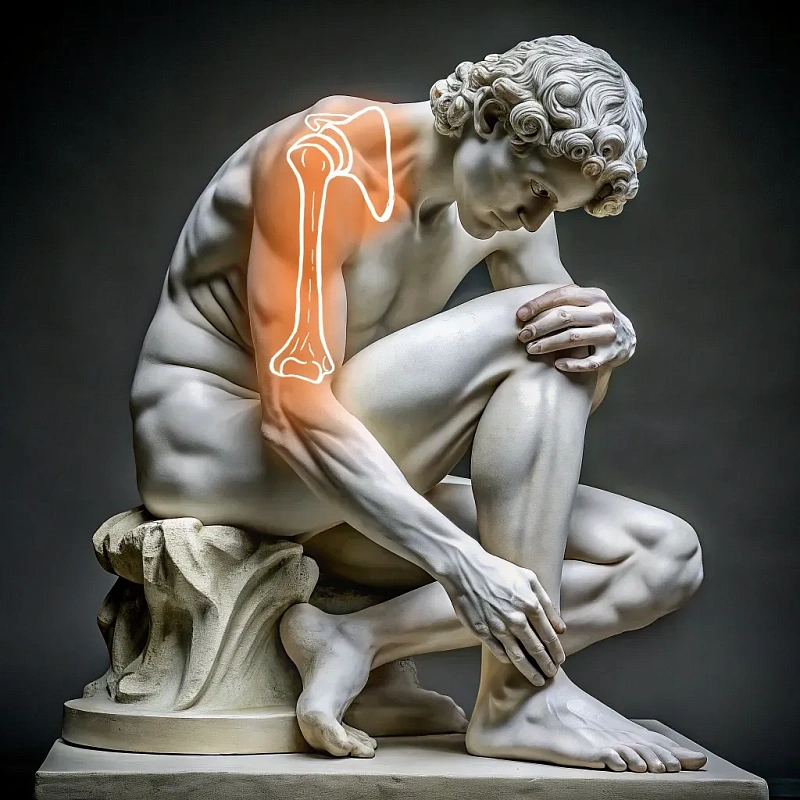Shoulder joint replacement (arthroplasty)
Shoulder arthroplasty is an advanced and effective surgery to replace the damaged components of the shoulder joint with an artificial prosthetics. Once the surgery is performed, the replaced joint will function and move no differently than a healthy shoulder.

The shoulder joint is one of the most agile in the human body. Conditions such as osteoarthritis, rheumatoid arthritis, as well as severe trauma and degenerative changes can lead to joint deterioration. The surgery enables complete restoration of joint function and return to an active lifestyle.
Modern prosthetics are designed to replicate the natural movement of the joint as closely as possible, allowing for proper movement and stability. The use of biocompatible materials reduces the risk of rejection and other complications.Modern prosthetics are designed to replicate the natural movement of the joint as closely as possible, allowing for proper movement and stability. The use of biocompatible materials reduces the risk of rejection and other complications. The surgery is performed using advanced technologies that increase the accuracy of implant placement and reduce rehabilitation period. Most patients can start easy movements the next day after the surgery, while full rehabilitation takes several months. .
Common blood and urine tests Pulmonary fluorography X-ray ECG Consultations with a general practitioner, an anesthesiologist, and specialized physicians Joint MRI
The most suitable prosthetics and arthroplasty method are selected based on each patient's specific characteristics. Full arthroplasty involves replacing both parts of the shoulder joint: the head of the humerus and the articular socket. The head of the humerus is replaced by a prosthetic shaped like a ball on a stem, the inner part of the humerus is prepared and the stem is implanted inside the bone. The socket is replaced with a prosthetic that imitates the cartilage surface. Once the prosthetics are secured, the surgeon conducts a final examination and closes up the incision.
Special medical tools for bone surface preparation. Advanced prosthetics made of biocompatible materials.
Rehabilitation starts the day after the surgery. First weeks after the surgery, the joint movement range is slowly increased under the supervision of a rehabilitation physician. Next, the physician prescribes procedures to strengthen the arm muscles. This may include physiotherapy, massage and exercise therapy. Full recovery generally takes 3-4 months.
Benefits
Pain relief
Arthroplasty significantly reduces or completely eliminates joint pain.
Mobility restoration
The prosthetics restore full joint function, allowing the patient to move freely and resume regular activity.
Durable performance
Advanced prosthetics can last 15-20 years provided all recommendations are followed.
Frequently Asked Questions
What kind of anesthesia is used for the surgery?
When is it safe to start moving the shoulder after the surgery?
How long does rehabilitation last?
How long does a prosthetic hip last?
Didn't find an answer to your question?
You can describe your problem in detail and ask a question to the doctor. He will answer you and help you find a solution
Врачи
Смотреть всех врачейCandidate of Medical Sciences. A surgeon and an orthopedic traumatologist. Head of the Department of General Orthopedics.
Similar referral activities
Arthroscopy of the ankle joint
Ankle arthroscopy is a minimally invasive surgical procedure used to diagnose and treat various diseases and injuries of the ankle joint.
Arthroscopy of the knee joint
Knee arthroscopy is a minimally invasive surgical procedure for the diagnosis and treatment of injuries and diseases of the knee joint. It allows examining the joint for damage and eliminating the identified defects.
Arthroscopy of the elbow joint
Arthroscopy of the elbow joint is a minimally invasive surgical intervention that allows for accurate diagnosis and simultaneous treatment of joint injuries.
Arthrodesis of the joints of the fingers of the hand
The destruction of the joints of the fingers of the hand is accompanied by pronounced pain and impaired functions. Arthrodesis is a surgical intervention in which the affected joint is completely immobilized, which relieves pain and progression of inflammation.
Arthroscopic revision of the cystic joint
The condition of the wrist joints determines the functioning of the hand. Arthroscopic revision is a minimally invasive diagnostic procedure that assesses the condition of the joint tissues, which is necessary for planning subsequent treatment.
Arthroscopy of the shoulder joint
Arthroscopy of the shoulder joint is a minimally invasive surgical procedure designed to diagnose and treat various diseases and injuries of the shoulder joint.
